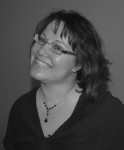Women warriors fight, die and live with a Band of Sisters
 Woman: sensitive, caring, nurturing, compassionate.
Woman: sensitive, caring, nurturing, compassionate.
Soldier: brave, determined, focused, loyal.
Woman soldier: all of the above.
Yes, women can be soldiers and soldiers can be women. And as we have seen in the last two decades – women are in the thick of combat, even as the official policies of the United States military contradict reality.
Women are serving in all five branches of the military. They drive supply trucks; pilot refueling planes, fighter jets and helicopters; provide medical care to wounded soldiers and enemy combatants, serve as Military Police and work in a variety of support and intelligence roles. Because the front lines in Iraq and Afghanistan don’t exist and the enemies’ IEDs and anti-aircraft missiles don’t discriminate, more than 130 female military personnel have died since the beginning of the current conflicts in the Middle East.
America’s female soldiers are breaking new ground both here and abroad. They are fighting and dying just like the men do.
It is this phenomenon that led author Kirsten Holmstedt to focus two books on the stories of female soldiers, both in the Iraqi theatre and after they returned home. Band of Sisters:American Women at War in Iraq (2007, Stackpole Books) and The Girls Come Marching Home:Stories of Women Warriors Returning from the War in Iraq (2009, Stackpole Books) explores what these women saw and experienced in Iraq and what female veterans face when they return home.
Holmstedt appeared at a book signing and discussion of her books at Dryhootch on Brady Street in Milwaukee. She said the books grew out of her Master’s thesis at the University of North Carolina in 2003. While her classmates were drawing from their personal stories and troubles for inspiration, Holmstedt chose the journalist’s path. She looked for the stories around her.
With Camp Lejeune in the next town and the Iraqi war heating up, she focused on the female military personnel who were her neighbors. While the male members of her family had served in the military, Holmstedt had to start from scratch with her research to understand the service, its history and the role of women. After she was armed with the basics, she approached the Camp’s public information officer for contracts.
Both books are fascinating studies in the strength and perseverance of this soldiers and are a great inspiration for women everywhere. Holmstedt said what she learned from the interviews and writing process was a greater compassion for her fellow women and men. But she refrained from describing herself as an expert on females in the military.
During the discussion at Dryhootch, female Army and Marine veterans explained what they really need to be effective on the field of battle and to heal once they came home.
Vera, who served in the 1980s, is now a veterans advocate. She truly believes female soldiers have to work harder to be taken seriously in the ranks and on the home front. She said the best thing all female veterans can do is to register their benefit claims as soon as they arrive home.
“I’m hooked on the VA (Veterans Administration),” she said. “I’m impressed with the health care provided at Woods (Clement J. Zablocki VA Medical Center), they provide health care options for women, care that I have received for 20 years.”
Vera added that the VA still has to recognize the fact that a woman is the veteran. She said when she first applied for benefits, the caseworker called out her last name. The worker then asked for Vera’s husband, assuming he was the veteran.
Another veteran from Oshkosh says more health care access is needed to serve female soldiers in rural parts of the state and nation.
“It’s great that there is access in Milwaukee and Madison,” she said. “But in northern Wisconsin, they don’t even have doctors on staff in the veterans clinics who are familiar with female health issues. That needs to change. Just put a female doctor in these clinics and the female vets will crawl out of the walls.”
Mary, a Vietnam-era Army veteran, said more outreach needs to be provided for all veterans and women in particular.
“There needs to be more compassion for veterans; we need a connection between veterans and civilians,” Mary added.
She said there needs to be more recognition by the Veterans Administration and the military of the sexual harassment and assault occurring on the battlefield and at home in hospitals and benefit offices. Mary cited cases of men harassing female veterans at the VA and both men and women being subjected to harassment and assaults while on active duty.
“We need more legislation and lawsuits to stop the harassment,” Mary said. “We need proper reporting and the acknowledgement that this occurs and needs to be addressed with medical and mental health services.”
A former Marine, Jen, agreed outreach is the answer to many veterans’ issues, but official government programs are not the answer. Instead, she wants to see more support for grass-roots, veteran-led outreach and counseling such as Dryhootch.
“This is the place where people learn to address issues,” Jen said. “This is a building block and tool to help veterans to take care of each other.”
Other members of the discussion group suggested public service announcements be used to get information about the multitude of benefits to veterans; a state-wide newsletter or paper to accomplish the same thing; and the use of radio to find veterans.
Jen gave her summation of what women veterans need, saying they want to be treated like soldiers and veterans at the VFW, but provided the medical and counseling services unique to women.
One way we as civilians can help is to learn about our military veterans, both women and men, and advocate for them and with them.
For more information about Dryhootch and the programs available for veterans, click here.
Lead photo image courtesy U.S. Army.






















